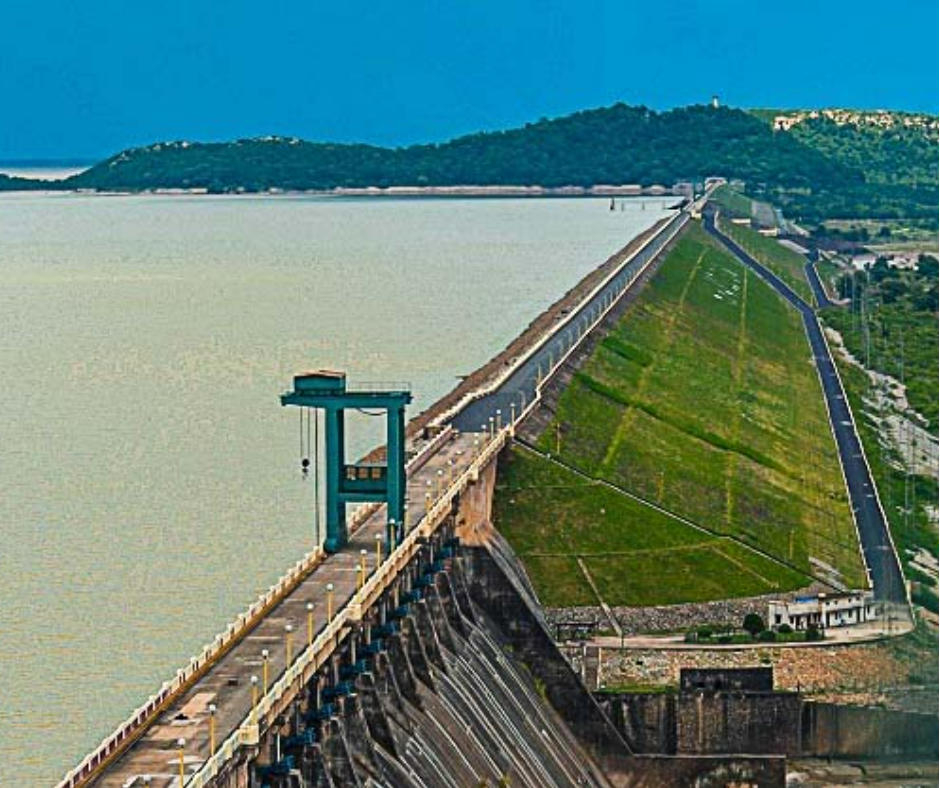Hirakud Dam: India's Largest Multipurpose Dam Harnessing the Power of Nature for India's Progress
- This gargantuan dam is the longest earthen dam in the world, stretching across the mighty Mahanadi River
- The dam stretches over 25.8 kilometers (16 miles) and has a maximum height of about 60 meters (200 feet)
- The dam generates up to 1,000 megawatts of hydroelectric power
Hirakud Dam: Introduction
The Hirakud Dam is a concrete gravity dam, located in the state of Odisha, India, is a monumental engineering feat that stands as a symbol of India's progress and its ability to harness the power of nature for the greater good. This gargantuan dam is the longest earthen dam in the world, stretching across the mighty Mahanadi River and the second-largest dam in India by power generation capacity. It has played a pivotal role in transforming the landscape of Odisha while contributing significantly to the country's economic development. In this article, we will delve into the history, significance, and impact of the Hirakud Dam on various aspects of Indian society.
Hirakud Dam: Location, Dimensions and Capacity
The Hirakud Dam is in the Sambalpur district of Odisha, about 250 kilometres from the state capital of Bhubaneswar. The dam impounds the Mahanadi River, which is the longest river in Odisha.

Hirakud Dam's impressive dimensions are a testament to its grandeur. The dam stretches over 25.8 kilometres (16 miles) and has a maximum height of about 60 meters (200 feet). The vast reservoir created by the dam has a total capacity of approximately 5,840 million cubic meters, making it one of the largest man-made lakes in India.
Hirakud Dam: History and Construction
The idea of constructing a dam on the Mahanadi River to harness its water resources was conceived as early as 1920. However, it wasn't until 1946 that the foundation stone for the Hirakud Dam was laid by India's first Prime Minister, Pandit Jawaharlal Nehru. The ambitious project aimed to tackle two major issues: mitigating the frequent and devastating floods in the region and utilizing water resources for irrigation and power generation.

The Hirakud Dam was built for a number of purposes, including irrigation, flood control, and hydroelectric power generation. The dam irrigates over 1.2 million hectares of land in the Sambalpur, Bargarh, Jharsuguda, Sundargarh, and Deogarh districts of Odisha. The dam also helps to control flooding in the Mahanadi River basin. The dam generates up to 1,000 megawatts of hydroelectric power.
The construction of the dam was a monumental engineering challenge. Spanning over a decade, the project required extensive planning, engineering expertise, and labor. Engineers from India and abroad collaborated to design and construct the dam. The dam itself is an earthen structure, consisting of two main sections - the left embankment and the right embankment - connected by the concrete spillway, the powerhouse, and the navigation lock.
Hirakud Dam: Flood Control and Irrigation
The Hirakud Dam has had a significant impact on the people and environment of Odisha. The dam has provided irrigation for agriculture, which has helped to improve food security in the region. The dam has also helped to control flooding, which has saved lives and property. The dam has also generated hydroelectric power, which has helped to meet the energy needs of Odisha.
One of the primary objectives behind the construction of the Hirakud Dam was to control the recurring floods that plagued the Mahanadi basin. Prior to the dam's completion, the region suffered from catastrophic floods almost every year, resulting in loss of lives, destruction of property, and disruption of livelihoods. The dam's reservoir effectively regulates the flow of water during the monsoon season, preventing downstream floods and safeguarding the region from water-related calamities.

In addition to flood control, the Hirakud Dam has played a crucial role in transforming the agricultural landscape of Odisha. The stored water is channeled through an intricate network of canals, facilitating irrigation across thousands of hectares of farmland. This irrigation system has not only increased agricultural productivity but also provided a lifeline to countless farmers in the region, reducing their dependency on rain-fed agriculture.
Hirakud Dam: Hydropower Generation
One of the most significant contributions of the Hirakud Dam is in the realm of hydropower generation. The dam's powerhouse, equipped with several turbines, harnesses the potential energy stored in the elevated water and converts it into electricity. The installed hydropower capacity is approximately 347.5 megawatts, contributing significantly to India's energy needs.
The eco-friendly nature of hydropower generation is a considerable advantage, especially in the face of growing concerns about climate change and environmental sustainability. By producing clean electricity, the dam has helped reduce the country's reliance on fossil fuels and has played a role in mitigating greenhouse gas emissions.
Hirakud Dam: Water Supply and Navigation
The Hirakud Reservoir also serves as a crucial water supply source for various industrial and domestic purposes. The cities of Sambalpur and Burla, along with several towns and villages in the vicinity, benefit from the reservoir's water supply. Industries in the region rely on the dam for their operations, boosting economic activities in the area.
Moreover, the dam's navigation lock facilitates the smooth movement of cargo vessels, thus promoting inland water transportation. This has not only reduced the burden on road and rail transportation but also provided a cost-effective means of moving goods and raw materials, bolstering regional trade and commerce.
Hirakud Dam: Environmental Impact
Despite the numerous benefits, the Hirakud Dam has not been without its share of controversies and environmental concerns. The dam's construction led to the displacement of thousands of people, with entire villages being submerged in the reservoir. This resulted in the loss of traditional livelihoods and cultural heritage for many communities, sparking protests and demands for proper rehabilitation and compensation.
Additionally, the dam's reservoir altered the local ecosystem, affecting the natural flow of the Mahanadi River and impacting the flora and fauna in the region. Changes in water levels and disruption of the river's natural course have raised concerns about biodiversity loss and water quality degradation. Environmentalists continue to monitor and address these issues, calling for sustainable management of the dam and its surroundings.
Hirakud Dam: At the End
The Hirakud Dam stands tall as a testament to human ingenuity and determination in India's journey towards progress and development. Its multifaceted benefits, ranging from flood control, irrigation, hydropower generation, water supply, and navigation, have significantly impacted the lives of millions in the region and contributed to India's economic growth.
About Hirakud Dam Share Your Thoughts on Instagram
Join Us
Stay updated with the latest Sarkari Jobs by joining our community. Follow us on social media and subscribe to our newsletter for regular updates.




